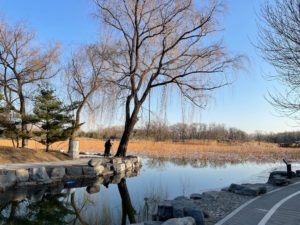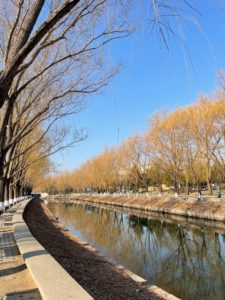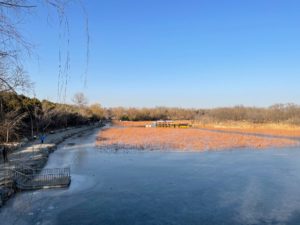【可持續發展目標13:氣候行動】

提及北京,除了長城和天安門,廣為人知的還有困擾其多年的重度霧霾。
在北京霧霾最為嚴重的那幾年(2012-2016),小編恰好在北京讀大學。在秋冬季節,常能看到灰白甚至泥土色的天空,空氣中的煙燻味和硫磺味,連室內都能聞到。在嚴重的霧霾天出門後回到家,用濕紙巾擦臉,紙巾上盡是一片黑,鼻子就更不用說了。記憶最深的一次,莫過於一連好多天,窗外都是混沌的泥黃色,分不出到底是日間什麼時分。室友叫的外賣,也看不清外賣小哥在哪裡。同學笑稱,上個大學不容易,熬到畢業分分鐘肺都黑了。
7年後,小編在2020年的冬季重返了一次北京。那一週裡北京每天都是萬里晴空(見下圖),空氣質量也明顯變好。經過這幾年來政府嚴格限制煤炭消費以及關停重污染工廠、環境監測技術的應用、PM2.5來源的解析等等一系列措施,北京的藍天終於變得更多了。2020年,北京連續322天無PM2.5重污染。同時,北京全年“好天”比2019年又多了36天。

這些經驗顯然值得其他發展中國家的一些城市參考。不過,根據北京市生態環境監測中心主任劉保獻在接受中新社專訪時提到,“京津冀區域的污染量在全國都是最高的,單位國土面積燃煤排放量是全國的四倍。雖然各個方面污染物排放有降低,但總的來講,城市降得多,農村降得少;2月份是采暖季,有大量供暖需求;輕工業停得多,重工業停得少,重工業比如鋼鐵、玻璃、焦炭這部分基本上沒有停。”
大氣治理是非常複雜的系統性、社會性的問題。取得了階段性進步值得高興,但未來的路仍不能鬆懈。在許多方面,例如如何協調城市和農鄉不一致的環保動機,成功將環保意識深入到各民眾階層,以及鼓勵企業去切實行動,政府仍有很多工作要帶頭做。願北京能像曾經的伦敦一樣,漸漸甩掉霧霾之城的帽子。
【Sustainable Development Goal 13: Climate Action】

When it comes to Beijing, in addition to the Great Wall and Tiananmen Square, it is known for the heavy smog that has plagued it for many years.
During the most severe years of smog in Beijing (2012-2016), the editor had been studying at an university in Beijing. During autumn and winter, the sky was often grayish and even earthy, and the smell of smoke and sulfur in the air can be smelled even indoors. On a severe smog day, the editor wiped her face with a wet tissue after going out, and the tissue was filled with black dust. It was the same in the nose. The most striking memory for the editor was that for many days in a row, the outside environment was covered in muddy yellow air, and she couldn’t tell what time it was in the day. Her roommate ordered the food delivery and couldn’t see where the delivery person was. Her classmate joked that going to university was not easy as students risking the health of their lungs by living in Beijing.
Seven years since then, the editor returned to Beijing in the winter of 2020. During that week, Beijing had clear sky every day (see the pictures below), and the air quality was obviously much better. Over the past few years, the government has strictly restricted coal consumption and shut down heavily polluting factories, and the environmental monitoring technologies were applied in different areas of the city, along with the analysis of PM2.5 sources and other measures. Finally, Beijing has seen more “blue sky” than before. In 2020, for 322 consecutive days, Beijing had no heavy PM2.5 pollution. In addition, Beijing had 36 more “good weather” throughout the year than in 2019.

These experiences are obviously worthy of reference for some cities in other developing countries. However, according to Liu Baoxian, director of the Beijing Municipal Ecological Environment Monitoring Center, “The pollution level in the Beijing-Tianjin-Hebei region is the highest in the country, and the coal emission per unit area is four times that of the country. Pollutant emissions in all aspects have been reduced, but in general, the urban area has dropped much, and the rural area has dropped less; February is the heating season, and there is a large demand for heating; industries with light pollution were halted more than industries with heavy pollution, and heavy industries such as steel, glass and coke have not been shut down.” He mentioned in an exclusive interview with China News Agency.
Air pollution is a very complex systemic and social issue. The staged progress is worthy of noting, but there is still a long road ahead. In many aspects, such as how to coordinate the inconsistent environmental protection motives between cities and rural areas, successfully spread the awareness of environmental protection to all people, and encourage enterprises to take concrete actions, the government still has a lot to lead. Hopefully Beijing can gradually get rid of its hat of a smog city, just like how London did before.
中国焦点面对面:北京的蓝天是如何多起来的?https://mp.weixin.qq.com/s/WPoQKakIN83wsN2d0wbFtw



